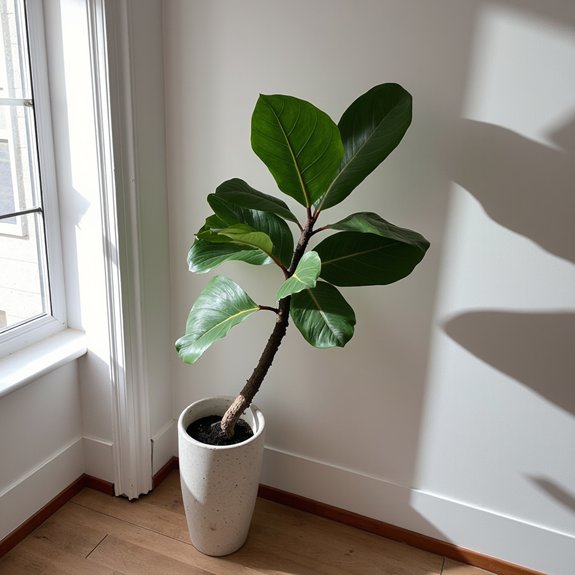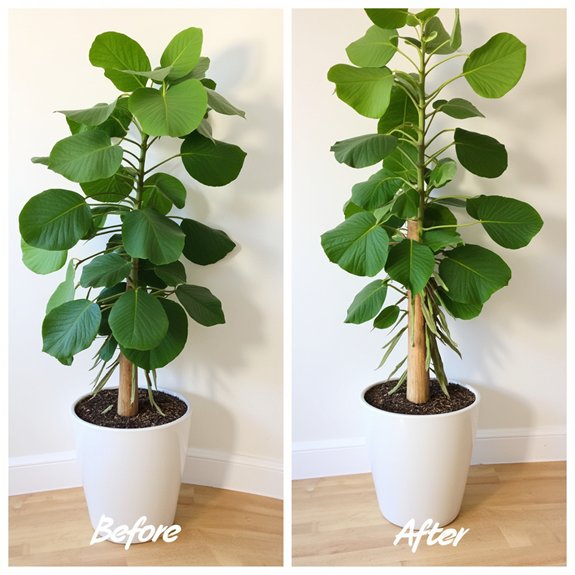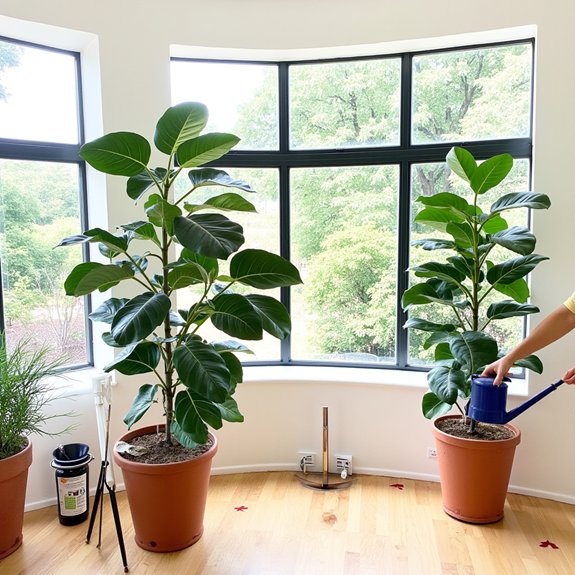Fiddle leaf figs develop an unfortunate lean when they chase light, creating that awkward tilted appearance that frustrates plant owners. This common problem stems from inadequate lighting conditions, weak root systems, or simply the plant’s natural growth patterns toward available sunlight. The leaning typically begins gradually, with stems stretching toward windows, but can progress to severe angles that threaten the plant’s stability and aesthetic appeal. Fortunately, several proven techniques can restore your fiddle leaf fig’s upright posture and prevent future leaning issues.
Contents
Why Your Fiddle Leaf Fig Starts to Lean

Why does a perfectly upright fiddle leaf fig suddenly develop a dramatic lean? The primary culprit is insufficient sunlight, causing branches to stretch desperately toward the nearest light source. This creates lopsided growth that worsens over time.
Several causes of leaning work together to create this problem. Inadequate nutrients weaken branch structure, while incorrect pot sizing affects stability. When plant height exceeds double the pot’s height, the weight becomes unmanageable.
Early signs of distress include thin branches, smaller leaves, and gradual tilting toward windows. Quick action prevents further leaning and saves the plant’s structural integrity.
Light Requirements for Healthy Upright Growth
Understanding proper lighting becomes the cornerstone of preventing that unwanted lean in the first place. Fiddle leaf figs crave bright indirect sunlight for ideal growth, mimicking their native forest canopy conditions. Place your plant within three to five feet of an east-facing window, where morning light filters gently through.
Avoid direct southern exposure, which scorches leaves. If your space lacks adequate brightness, gradually relocate your plant over two weeks. This prevents shock while encouraging sturdy, upright development.
Rotate the pot one-quarter turn weekly, ensuring even light distribution. Consistent, proper illumination eliminates the stretching behavior that creates structural weakness.
Step-by-Step Solutions to Fix a Leaning Plant

Once a fiddle leaf fig starts leaning, immediate action prevents the problem from worsening and helps restore proper growth patterns. First, relocate the plant to a brighter location, preferably near an east-facing window. Position the leaning side toward the light source, encouraging upward growth over 2-3 weeks.
For severe leaning, install bamboo stakes or moss poles as plant supports. Gently tie branches using soft cloth strips, avoiding wire that damages stems. These leaning solutions work best when combined with gradual light increases.
Finally, prune stretched branches at a 45-degree angle, promoting bushier, upright growth patterns.
Repotting and Nutrition for Stronger Branches
While proper lighting addresses immediate leaning issues, weak branches often indicate underlying nutritional deficiencies that require repotting every 2-3 years. Fresh potting soil restores depleted nutrients, strengthening branch structure and preventing future leaning episodes. The proper repotting frequency guarantees roots have adequate space and access to essential minerals.
During repotting, examine root health and refresh the soil completely. A balanced liquid fertilizer applied monthly maintains nutrient balance between repotting sessions. Strong branches develop when plants receive consistent nutrition, proper drainage, and appropriately sized containers. Remember, plant height shouldn’t exceed double the pot’s height to maintain stability.
Ongoing Care Practices to Prevent Future Leaning

Several key maintenance habits form the foundation of preventing future leaning episodes in Fiddle Leaf Figs. Establish a consistent watering schedule, allowing soil to dry between sessions while maintaining steady humidity levels around 40-50%. Position plants near east-facing windows for ideal light exposure, rotating them weekly to guarantee even growth. Regular pruning controls weight distribution, preventing branches from becoming too heavy. Monitor pot size annually, confirming plant height doesn’t exceed double the container’s height. Apply balanced fertilizer monthly during growing season to strengthen branch structure. Check for pests quarterly, as infestations weaken plants and contribute to structural problems over time.
